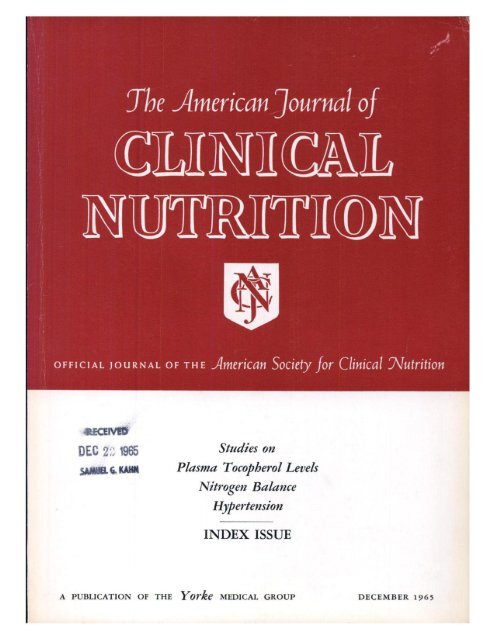年龄和性别对单剂量混合类黄酮尿液消除的影响:来自健康英国成人单臂干预的结果
IF 6.5
1区 医学
Q1 NUTRITION & DIETETICS
引用次数: 0
摘要
背景:营养干预试验表明,增加类黄酮摄入量对疾病结局/生物标志物有临床意义的影响;然而,观察到吸收和代谢的高度变异性以及生化和生理反应的巨大异质性。这种变异的病因尚不清楚。目的:探讨性别、年龄和微生物种类对混合类黄酮24小时(h)消除的影响。方法:根据年龄(18-30岁或65-77岁)和性别前瞻性招募健康男性和女性(n=163),食用标准的富含类黄酮的测试餐,提供640毫克可可/巧克力黄烷-3-醇,340毫克柑橘黄烷酮和390毫克黑莓花青素。采用超高效液相色谱-质谱联用(UPLC-MS/MS)对基线(-24 h ~ 0 h)、0 ~ 3.5h、3.5h ~ 7 h和7 ~ 24 h采集的尿液样品进行黄酮及其代谢物的分析。通过Illumina测序确定粪便微生物组的种类。使用线性混合效应模型来评估不同年龄和性别的累积排泄差异,并以分组时间相互作用为主要效应分析。结果:24h尿代谢物总回收率无组间差异(老年女性、老年男性、年轻女性、年轻男性),但老年男性24h累积回收率有较高的趋势(β (95% CI) -61.4(年轻男性比老年男性-107,-16.0);p组24h =0.06)。在76种代谢物中,20种代谢物的Tmax因年龄而有显著差异,9种代谢物的Tmax因性别而有显著差异,年龄较大的参与者的Tmax平均值较晚(占92%)。与年龄的关联不是由BMI或微生物组物种介导的。只有6种代谢物的Cmax在性别上存在显著差异,5种代谢物在年龄上存在显著差异。结论:多酚的总消除回收率在不同年龄和性别群体中相对一致,但消除动力学存在较大差异;可能是由于肠道转运时间或肾脏清除的差异。假设(多)酚代谢物具有不同的生物活性,需要建立剂量反应关系,并确定人群亚群中的代谢物谱,以告知未来膳食黄酮类/(多)酚推荐的发展。临床试验注册:NCT01922869。本文章由计算机程序翻译,如有差异,请以英文原文为准。
Effect of age and sex on the urinary elimination of a single dose of mixed flavonoids: results from a single-arm intervention in healthy United Kingdom adults
Background
Nutrition intervention trials demonstrate that increased flavonoid intake can have clinically meaningful impacts on disease outcomes/biomarkers; however, high variability in absorption and metabolism and large heterogeneity in biochemical and physiological responses are observed. The etiology of this variability is poorly understood.
Objective
The objective of this study was to explore the relationships between sex, age, and microbiota speciation on mixed flavonoid elimination over 24 h.
Methods
Healthy males and females (n = 163) prospectively recruited on the basis of age (18–30 y or 65–77 y) and sex consumed a standardized flavonoid-rich test meal providing 640-mg cocoa/chocolate flavan-3-ols, 340-mg citrus flavanones, and 390-mg blackberry anthocyanins. Urinary samples collected at baseline (−24 to 0 h), 0 to 3.5 h, >3.5 h to 7 h, and >7 to 24 h were analyzed for flavonoids and their metabolites by ultra-high-performance liquid chromatography-mass spectrometry (UPLC-MS/MS). Stool microbiome speciation was determined via Illumina sequencing. Linear mixed-effect models were used to assess differences in cumulative excretion across age and sex with time-by-group interaction taken as the principal analysis of effect.
Results
There were no group (older females, older males, younger females, and younger males) differences in total 24 h urinary metabolite recovery, but there was a trend toward a higher rate of cumulative recovery in older males versus younger males at 24 h (P-group at 24h = 0.06). Of 76 metabolites, 20 had significantly different times of maximum urine excretion (Tmax) by age and 9 by sex, with a later mean Tmax observed for older participants (92% of instances). Associations with age were not mediated by body mass index (BMI) or microbiome speciation. Significant differences in maximum urine excretion (Cmax) by sex were observed for only 6 metabolites and differences by age for 5 metabolites.
Conclusion
Total elimination recovery of (poly)phenols was relatively consistent across age and sex groups, whereas elimination kinetics (Tmax) differed substantially being much later in older indivudals, possibly resulting from differences in intestinal transit time or kidney clearance. Assuming (poly)phenol metabolites have varying biological activities, establishing dose-response relationships and defining metabolite profiles in population subgroups is required to inform the future development of dietary flavonoid/(poly)phenol recommendations.
This trial was registered at clinicaltrials.gov as NCT01922869
求助全文
通过发布文献求助,成功后即可免费获取论文全文。
去求助
来源期刊
CiteScore
12.40
自引率
4.20%
发文量
332
审稿时长
38 days
期刊介绍:
American Journal of Clinical Nutrition is recognized as the most highly rated peer-reviewed, primary research journal in nutrition and dietetics.It focuses on publishing the latest research on various topics in nutrition, including but not limited to obesity, vitamins and minerals, nutrition and disease, and energy metabolism.
Purpose:
The purpose of AJCN is to:
Publish original research studies relevant to human and clinical nutrition.
Consider well-controlled clinical studies describing scientific mechanisms, efficacy, and safety of dietary interventions in the context of disease prevention or health benefits.
Encourage public health and epidemiologic studies relevant to human nutrition.
Promote innovative investigations of nutritional questions employing epigenetic, genomic, proteomic, and metabolomic approaches.
Include solicited editorials, book reviews, solicited or unsolicited review articles, invited controversy position papers, and letters to the Editor related to prior AJCN articles.
Peer Review Process:
All submitted material with scientific content undergoes peer review by the Editors or their designees before acceptance for publication.

 求助内容:
求助内容: 应助结果提醒方式:
应助结果提醒方式:


